





Ever wonder why rock garden plants are typically short, evergreen, mat or mound-forming? Why are they often so prolific in their blooming? It all comes down to adaptations that allow them to survive in rigorous alpine climates. After reading this article, you will hopefully have a better appreciation of this choice group of garden plants and why they often present challenges in their cultivation.
One of my favourite groups of plants are alpines. They may not be as flamboyant as say, begonias, dahlias and roses, but the variable forms and textures exhibited by alpine plants and their often small, but exquisite blooms, I can't resist. Anyone who has grown alpines will know that have certain features that make them recognizable as alpines. Mat-like growth, taproots, tight buns, fuzzy foliage...these are just some of the features that we, as alpine growers, find so attractive. However, these alpine features have a purpose. Alpines environments are rather harsh and plants must adopt certain habits if they are to survive. This article on the adaptations of alpine plants will hopefully give you a better appreciation of this wonderful group of plants.
The word alpine comes from the Latin alpes which means ‘high mountain'. When you think of the high mountains, you think cold, windy, snowy...essentially winter. Features that might not come immediately to mind are low carbon dioxide and oxygen levels, high UV levels, summer frosts, poor soil, drought and low pollinator diversity. All of these features are what determine the growing habits of alpine plants. A number of these features also affect Arctic-affinity plants hence those plants found in the high Arctic often have similar characteristics to alpine plants. In fact, as an interesting note, all of the alpine plants found in the highest peaks of the Appalachians are also found in the high Arctic.
First, let's look below ground. A common feature of arctic-alpines is to have deep-delving roots or a deep taproot. This feature helps stabilize the plants in an area where soil is constantly on the move. Gravity is constantly pulling soil down from the sides and tops of mountains. Frost action in spring and fall can be quite severe and leads to churning of the soil. Gardeners know that shallow-rooted plants are often sitting on top of the ground in spring due to soil frost churning during the winter months. Deep taproots help stabilize the alpines. In the garden, such taprooted plants need to be planted while young as they resent disturbance once they become fully established.
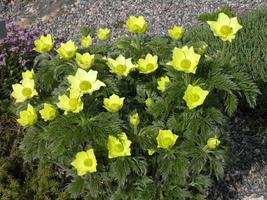
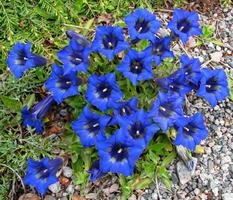
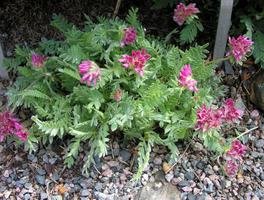
Examples of tap and/or deeply-rooted alpines include pasqueflowers, gentians and oxytropes
The soils of arctic-alpine regions are generally poor in nutrients. The short growing season and cool soil temperatures results in the slow decomposition of organic matter hence many nutrients become unavailable. This results in slow growth rates of arctic-alpine plants and their low requirements for extra fertilizing. In fact, in the garden, too much fertilizer will cause alpines to grow to death!
Arctic-alpine are generally very low in height. The reason for this is two-fold. Wind is an ever-present problem in arctic-alpine environments. The wind blowing over the soil surface is never as strong as above so mat or mounding plants are not as exposed to wind. In addition, low growth means a better chance of staying covered by snow which is one of the best insulators against extreme cold. Temperatures in arctic-alpine regions are generally low. The air temperature at the soil surface is always warmer than just above, so low habit plants are kept warmer simply by their short height. Alpine studies have shown that on sunny days when the air temperature 50 cm above the surface was only 5 C, the temperature at the soil surface may exceeded 20 C. Mound-forming plants are even better at trapping heat than the mat-forming. On a sunny day, even when the air temperature is slightly below freezing, the temperature within a mounding alpine can be several degrees above freezing, allowing the plants to commence growth. Of course this has its drawbacks when growing some of these plants in our gardens, as they literally burn-up under typical temperate summer temperatures.
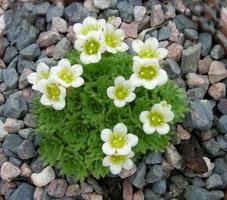
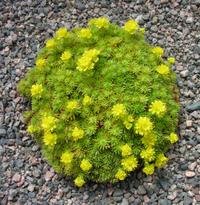
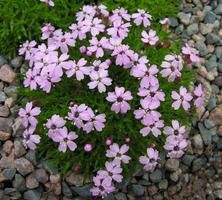
Examples of mound-forming alpines include saxifrages and moss campion
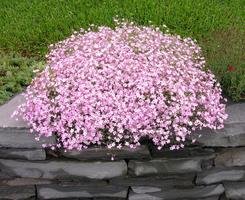
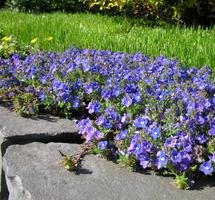
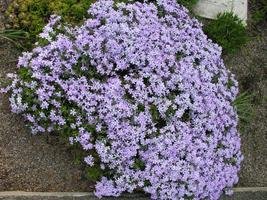
Some examples of mat-forming alpines include creeping baby's-breath, creeping speedwell and creeping phlox
Many alpines have evergreen leaves. This feature allows them to start photosynthesizing as soon as the air temperatures rise above freezing. The time required to ‘leaf-out' is too time-consuming when you live in a short growing season area. Their leaves are often purple-flushed, especially during cold weather. This colour is due to extra anthocyanin production. This compound can act as a sun-screen to protect against high UV light levels, the darker foliage will heat up more quickly in spring (e.g., a black car will get hotter than a white one) and the anthocyanin can also act as a form of anti-freeze.
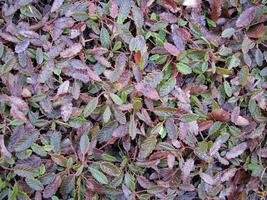
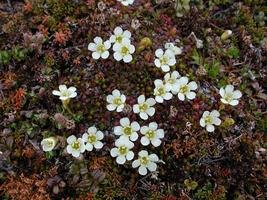
A couple of examples of alpines whose leaves turn purplish in winter include mountain avens and alpine diapensia
Succulent and/or fuzzy foliage is also common among arctic-alpines. While such regions are often snow-covered for months on end, the rather gravelly soils are very well-drained and drought can be evident by mid-late summer, especially in the Rockies. Succulent foliage helps combat against this problem. Fuzzy and succulent leaves also reduce transpiration rates (loss of moisture due to wind) further helping the plants cope with dry conditions. Fuzzy foliage can trap warmer air around the leaves of the plants as it breaks the force of wind blowing over the leaf surface. This can lead to above freezing temperatures around the plant even when the air temperature is below freezing.
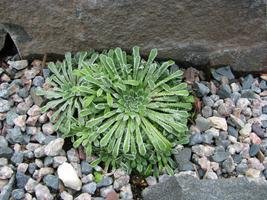
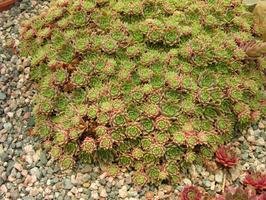
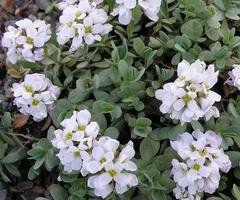
Succulent-like leaves may be found on encrusted saxifrage, Sempervivum and Eunomia oppositifolia
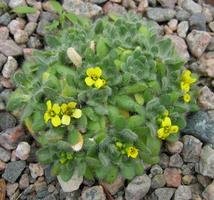
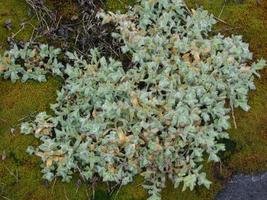
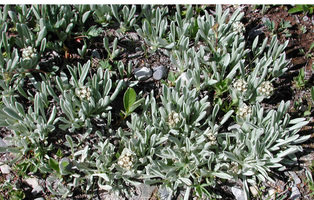
Fuzzy foliage is evident on many Draba, Cerastium alpinum and Antennaria
Arctic-alpine plants are amazingly resilient to summer frosts and snows. I have seen snow falls in Glacier National Park in mid-June that buried fields of blooming alpines. When the snow melted a few days later, the plants looked no worse for wear. Night frosts in arctic-alpine regions are common, even during the summer months so these plants must be able to cope with these extremes. Imagine the mess of a summer snowfall on a garden of dahlias!
Lastly, let's look at the blooms of these plants. Most high arctic-alpines bloom within weeks of the melting snow. Southern alpines from longer growing seasons can have the luxury of blooming later in the season, but those from the high or northern alpine regions have to bloom and set seed within a few short weeks. Many alpines have cup or saucer-like blooms that act like a parabolic lense, actually allowing the inside of the blooms to be warmer than the outside. Pollinating insects take advantage of this, ‘hanging-out' inside the blossoms where it is warmer. From the plants perspective, this increases their chances of being pollinated. Some arctic-alpines blossoms go as far as turning on their stalks to follow the sun, maximizing the exposure of their flower centers to the warming influence of the sun (sunflowers do this too).
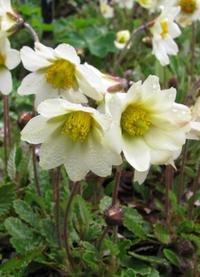
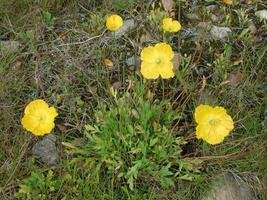
Flowers that follow the sun can be seen on mountain avens and Iceland poppies
Flower colour is also important. White flowers can trap some heat and may be a degree or two warmer than the leaves. White flowers are attractive to generalist pollinators. This is important in a region where pollinator activity and diversity is low. Blue and purple flowers trap more heat than white (refer once more to the black vs. white car in the sun scenario). This colour is also more attractive to bees, perhaps the most important pollinators in the world. While typical bees are absent to scare in high alpine regions, bumblebees are relatively common. They can be active at temperatures much lower than other insects can tolerate. If too cold, they will literally walk from flower to flower rather than fly (again, taking advantage of the fact the temperature is warmer at the soil surface than in the air above). The more flowers you produce, at the same time, the better your chances of being seen and visited by pollinators. Hence, arctic-alpines often have spectacular floral displays literally covering themselves in flowers.
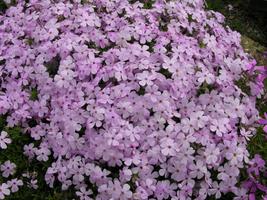
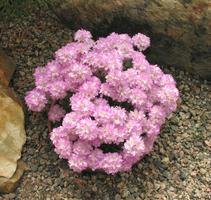
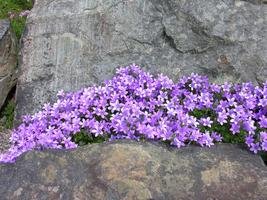
Examples of mass flower displays are evident on many creeping phlox, thrift and bellflower species
This brief look at arctic-alpine adaptations will hopefully give you a better appreciation of why these plants look like they do. It is all part of Nature's grand scheme for survival. While these plants may exhibit a delicate beauty, they are, in fact, among the toughest plants in the world. However, from a cultivation point of view, these adaptations are what makes growing some of these alpines so difficult. They are well prepared for an alpine climate, but cannot cope in our warm, lowland gardens. But as gardeners, nothing is better than a good growing challenge and alpine growers probably have more than their fair share!
Copyright © www.100flowers.win Botanic Garden All Rights Reserved